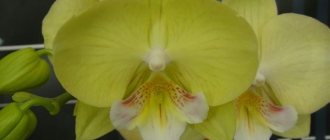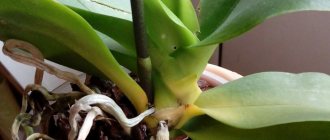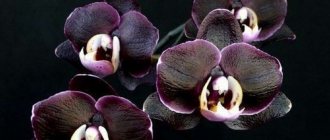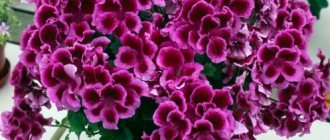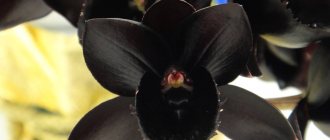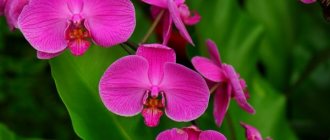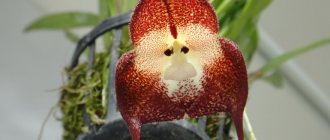The orchid flower is one of the beautiful and unique representatives of the green world. You probably won’t find a gardener who doesn’t like this amazing plant. You can find everything about orchids in our article.
It was first mentioned at the beginning of the 7th century BC. e., but some experts believe that people learned about representatives of the orchid family much earlier.
From ancient times to this day, the plant symbolizes chastity, harmony, and perfection.
Mention of the orchid flower in ancient manuscripts
Among culture lovers, there is an opinion that varieties of orchids are the result of the work of modern breeders, but this reasoning is erroneous.
Records of exotic flowers have been found in Chinese manuscripts. In addition, the ancient Chinese alphabet had the character “lan”, meaning the word “orchid”, and its varieties:
- celestial orchid - “Tin Lang”;
- orchid scent - “Lan Fong”;
- resembling an orchid - “Yeuk Lan”.
In addition, Chinese artists, and later Japanese ones, painted birds next to orchids.
One of the manuscripts, dating back to 700, reported on an artist who grew an unusual flower at home.
In his philosophical writings, the Chinese sage Confucius compared the phrases uttered by close friends to the delicate fragrance of noble plants.
Homeland of the orchid
Today the flower has conquered the whole world. These noble tropical inhabitants grow on almost all continents, except in deserts and where polar bears live.
In Russia alone there are more than five hundred species of orchids. This diversity is explained by climatic conditions and natural methods of growth, which is why many plants are divided into:
- epiphytes;
- lithophytes;
- herbaceous.
For each of them, their homeland is a place with the most comfortable natural conditions for growth.
Epiphytes
The tropics are the habitat of most epiphytic species, since the hot and humid climate of tropical latitudes, where prolonged rains are replaced by prolonged drought, is ideal for orchids.
It is no coincidence that flowers are comfortable:
- in tropical rainforests of South America;
- India;
- Indonesia;
- southwest Asia;
- in the north of the Australian continent.
Epiphytes grow on trees, but are not parasitic because they do not feed on the sap of the plants on which they live. Tree trunks serve as a support for flowers to hold on to with strong roots.
The roots absorb moisture from raindrops, and light promotes photosynthesis. Epiphytes have thick stems because they contain a lot of stored moisture, due to which orchids easily tolerate drought.
Climatic conditions affect the life cycle of plants. With the onset of the dry season, the development of flowers slows down, only to then grow and bloom rapidly.
Litofitov
Flowers grow on rocky and rocky mountain slopes. Plant growth and development also require a humid climate. Since flowers live above sea level, they easily tolerate temperature fluctuations.
Peru, Venezuela, Brazil - countries with a tropical climate are considered the birthplace of lithophytes.
grassy
These representatives of the orchid family grow and develop exclusively in their natural habitat. Plants in indoor pots will die.
Flowers prefer temperate climates:
- South America and North;
- European countries;
- Central Asia.
Lyubka bifolia, Lady's slipper - orchids growing in Russian regions are so rare that they are listed in the Red Book.
Plant care
To maintain comfortable conditions that ensure good growth and flowering of the orchid, it is important to follow:
- ensuring good lighting;
- for proper watering;
- for choosing suitable soil;
- for timely replanting and fertilizing of the plant.
Each of the listed conditions is very important for the proper maintenance of this exquisite plant.
Required lighting
Sufficient light supply is a determining factor in the appearance of new flowers and maintaining the duration of flowering. Provided that there is not enough light for the orchid, the optimal vegetation cycle will be disrupted. If the light is too intense, the orchid burns out. A characteristic sign of insufficient light intake is the appearance of darkish spots on the leaves of the plant. The yellowness of the leaves and brown spots on them indicate that there is excessive lighting.
When choosing a place where this plant will grow, you should avoid window sills on the sunny side. The ideal place for an orchid to bloom well is a glazed loggia facing west or east. A loggia on the south side will have to be darkened with special curtains to keep the plant, and on the north side the indoor plant will not bloom and may even die.
Proper watering
Experts are confident that the orchid begins to die due to the appearance of stagnant moisture in the soil, as well as due to the effect of salts dissolved in the irrigation liquid on its roots. It should be noted that this potted plant tolerates soil drying out better than its excessive moisture.
The frequency of watering is usually influenced by the following factors:
- average indoor air temperature;
- air humidity;
- frequency of exposure to sunlight;
- flower pot size;
- growing season.
To determine the frequency of soil moisture, it is worth considering each of the listed factors. Lack of moisture contributes to the appearance of pseudobulbs and dry leaves. With excessive moisture, the process of rotting of the orchid roots begins, which soon affects the condition of the plant as a whole. How experts recommend watering: Place the pot with the plant in a small container of water at room temperature for a quarter of an hour. Place the plant in the bathroom and water it quite intensively, using slightly warm water in the shower. Make sure that the substrate is completely wet and that excess water comes out of the special holes at the bottom of the pot. Using both methods, after watering, place the pot on a small wire rack and allow excess moisture to drain completely.
Soil selection
The exquisite beauty of the orchid needs a fairly light substrate, which is not at all reminiscent of the fertile soil necessary for other plants. Its composition should include: crushed pieces of tree bark and coal, small clay granules, small cork particles, sand, forest moss, special plant components, perlite or vermiculite. For plants that take root in the ground, pieces of dry tree leaves are added to the soil.
Timely replanting and fertilizing
The flower is replanted no more than once every 2 years. During active growth and the appearance of flowers, the orchid needs feeding. The plant needs to be fed with a specially developed fertilizer and this should be done no more than once every 14 days. While watching the video you will learn about the propagation of orchids. Taking into account the listed rules for caring for orchids, the owners of this wonderful plant will enjoy its flowering on their windowsill for a long time.
Origin story
There is no consensus among flower growers about the history of the origin of flowers. Some believe that the birthplace of the orchid is China, others call it South America.
For the first time, plants with this name were reported by the Greek thinker Theophrastus (IV-V centuries BC). In his work on the medicinal properties of the inhabitants of the plant world, he talks about flowers with two tubercles and rounded roots, to which he gave the name “orchis” (translated from Greek “egg”).
When talking about the origin of flowers, one should keep in mind not just one country, but a place where the climate is humid, the plants are abundantly green, through which the sun occasionally peeks. There are places in China that are favorable for orchids, and it is possible that the plant’s homeland is Chinese forests.
Without magic, nowhere
Like many representatives of the flora, orchids also did not escape the fate of being classified as magical plants. In what exercissistic “experiments” did the flower not participate? For example:
Greek pharmacologist Dioscorides, who lived in the 1st century AD. described in detail how tubers can be used to get rid of evil spirits. Being a well-known and respected physician and biologist at that time, he confirmed his correctness with scientific justifications and numerous experiments.
The Chinese scientist Pen Tsiao, who wrote a voluminous work in the 16th century listing options for combating evil spirits, spoke in approximately the same vein. At that time, it was common to use the concept of negative energy and vibration.
Orchids were a fairly significant tool in the dark affairs of witches in medieval Europe. All kinds of tinctures, potions and other “tools of labor” of black magicians were actively used for various love spells.
The Russians also did not ignore the miraculous properties of the flower. Dendrobium and pseudobulb leaves were used to make brooms, which were then used to sweep houses from which the dead were removed. It was believed that in this way death would be driven out of the room, and the family would not have any illnesses or misfortunes for a long time.
The natives of the Solomon Islands used Dendrobium as a talisman for scouts and hunters. The plant served as a guarantee that the warrior would be safe under any circumstances and would return home safe and sound. Since the flowers of this type of orchid resemble dogs in appearance, they also served as food for hunting dogs. It was believed that after such a ritual the animals became more resilient, energetic and brave.
Mexican sorcerers who practiced meditative time travel used the inflorescences of the Vanilla Planifolia orchid for food, thereby opening the way to the other world.
First documentary mentions
Orchids were first mentioned in 500 BC. e.
- Ancient Chinese manuscripts reported two types of flowers: cymbidiums and cegolines.
- The ancient sage Confucius spoke about plants.
- For about 2.5 thousand years, the hieroglyph “lan” has existed, which describes orchids.
- A Chinese manuscript (700 BC) tells the story of an artist named Wang Wei who managed to grow a flower outside its natural environment.
A piece of amber found in the Dominican Republic with a bee frozen inside and a piece of an organ belonging to an orchid stuck to it. The discovered amber, according to scientists, is approximately 18 million years old.
Appearance in Europe
European countries could not resist the refined beauty of exotic plants.
In the 18th century, a botanist from England was given an orchid tuber sent from the Bahamas. A year later, an unusual flower blossomed for the scientist, the beauty and fragrance of which amazed the sedate Englishmen.
There were so many people who wanted to have tropical flowers at home that they started talking about the orchid disease that was sweeping the country.
A century passed until the British learned to grow tropical plants in artificial conditions to satisfy the demand of all residents. Attempts to create the necessary conditions for plant growth and development often failed. But the efforts were not in vain - majestic exotic flowers of different orchid colors bloomed in English gardens and greenhouses.
From England, a triumphal procession of plants began throughout Europe. Demand exceeded supply for a long time.
Resourceful traders went to the distant Amazon to buy exotic flowers, where they often died at the hands of rivals or bites of insects and snakes.
Prevention of various problems
How to prevent orchid diseases:
- The leaves have become yellowish and have lost their bright, rich green color - reduce watering, adjust air humidity, and shade the windows.
- If the leaves begin to fall, then the humidity is insufficient, you have dried out the air. And perhaps the substrate also does not receive enough moisture. Spraying and additional watering are required.
- Leaves rot is a sign of improper care. Make sure that the leaves, sinuses, and rosette do not get wet, and if they get wet, they should be carefully wiped with a dry cloth or dried with a hairdryer.
Where was it brought to Russia from?
In the 19th century, pan-European interest in orchids also spread to Russia. The deliveries were carried out by Sandler's company.
These are good times for exotic fans (wealthy people). It became possible to purchase simple types of flowers without leaving the homeland, and rare specimens were ordered from abroad.
This is how priceless private collections were born.
The mass worship of exotic flowers by the nobility is evidenced by the fact that in the period from 1892 to the October Revolution in 1917, more than a dozen books on growing plants of the orchid family were published, most of which were written by domestic authors.
The second wave of interest in orchids came in the post-war years. Exotics were brought to the USSR from Germany, from greenhouses owned by Goering. The Moscow Botanical Garden began to cultivate many varieties of tropical exotics.
Key Facts
- The name of the genus comes from the Greek. phalaina – night butterfly, moth, opsis – resemblance.
Orchids can be grown in the back of the room under artificial light. But wherever the flower stands, it needs 12 hours of daylight.
- Among domestic fluorescent lamps, “LD” or “LDC”, which produce white light, are suitable for illuminating phalaenopsis.
- The roots of the flower are capable of photosynthesis, and in places illuminated by sunlight they are colored green by chlorophyll.
- Plants that bloom in winter require more abundant watering than plants that do not bloom. For their normal development, it is necessary that the root system is not overcooled.
- Planting small specimens and children differs only in the size of the substrate particles. In the lower part of the pot, above the drainage, you can use a fraction of up to 1.5 cm, the rest of the bark should be no more than 1 cm.
In large bark, children and small specimens develop poorly.
- Due to low humidity, orchid roots on the surface of the substrate often have a wrinkled, non-viable appearance, but this is not a reason for concern.
- If it is not possible to give the plant illumination in winter, you can switch it to spring-summer flowering and have a rest in winter.
- To plant phalaenopsis babies, you can use pure sphagnum moss. But in this case, watering is more difficult, leaves grow faster, and roots grow worse.
- During flowering, it is advisable to tie the flower stalks to a peg.
Video
Variety of orchid varieties
According to their growth characteristics, plants are divided into 2 large groups.
- Flowers grow horizontally. They reproduce in the same position. The plants look like vines spreading in different directions; new roots with pseudobulbs emerge from the axils of the leaves. Plants are called sympodial: Cattleya, Cambria, Cybidium, Oncidium.
- Monopodial flowers are those that grow vertically from one point. Shoots grow from the axils of the leaf blades and stretch upward.
More than thirty thousand plants of the orchid family are known, and the number is growing every year. Among them there are several important groups.
- Brassia. South America - where these orchids come from. Another name for the flower is “spider”. There are approximately 35 varieties of this species. Spotted and Warty are the most famous.
- Cattleya. Plants are sympodial in growth type. More than 187 varieties belong to this species. Orchids can be any color, but not blue. At home they bloom once a year.
- Cumbria. Flower growth type is sympodial. The variety of colors is amazing.
- Ampelous orchids - cybidium. They require simple care. Japan and Australia are the birthplace of the plant. They bloom magnificently and have an exquisite fragrance.
- Phalaenopsis is one of the most famous orchids on our windowsills. All flowers are similar in shape to butterflies (they are called butterflies), and the variety of colors is great. The plant growth type is monopodial.
Thanks to the work of modern breeders, new varieties and hybrids of orchids have appeared.
Traditions and legends
There are many legends and stories regarding the appearance of orchids on earth. They are all amazing in their own way, and even if a sober mind suggests that all this is not true, listening to mythical fables is still pleasant. Here are the most famous of them.
- Aphrodite and Adonis, despite all the speculation and disapproval of the gods of Olympus, fell in love with each other. Being in the heat of feelings, they did not part for a minute and did not hide their passion. One day, while walking, Zeus saw a couple in love and became so angry that he began to furiously throw thunder and lightning, shaking with curses. To shelter from the bad weather, Adonis and Aphrodite fled to the first cave they came across and, of course, indulged in lovemaking. In a fit of passion, the goddess, like Cinderella, lost her shoe. Soon a flower grew in this place, later becoming a symbol of love and fidelity.
- The flowers of many orchids resemble fairy-tale insects, dragons and other semi-fantastic creatures. And some of them are very similar to spiders, and there is a mythical explanation for this. According to the ancient Greek legend, in the land of Lydia there lived a girl, Arachne, who knew how to spin carpets of amazing beauty. No one could compare with her in skill, and then, confident in her superiority, the weaver challenged the goddess Athena herself “to a fight.”
The carpet woven by Athena was striking in its magnificence, but Arachne decided to outdo her and made a “return”, where she depicted pictures of the love affairs of Zeus and other gods who did not shine with chastity. The angry Athena could not admit defeat and tore her rival's carpet into small pieces. Unable to survive the blow, the girl hanged herself. By that time, the goddess had changed her anger to mercy and turned the suicide into a spider.
In addition to numerous legends, the theme of orchids was often seen in the works of art of modern writers, as well as in films. Consider H.G. Wells' story about a man-eating orchid that hunted unwary travelers.
The homeland of the indoor orchid is China.
More than four thousand years ago, the Chinese cultivated orchids outside natural conditions. The biography of indoor orchids begins with Phalaenopsis - one of the ancestors of domestic flowers.
In their homeland, China, plants preferred to grow in low-lying, humid forests, up to half a kilometer above sea level. Therefore, Phalaenopsis grown in nature does not look the same as an indoor flower, since hybrids grow on window sills, in the cultivation of which the scientific method of mixing dozens of ancestral species was used, which is why the individual properties of the plant have changed.
The height of an adult home flower is from 20 cm, but not more than half a meter. If you compare how many leaves there should be, the differences are obvious: 2-3 pairs in phalaenopsis; more than a dozen - in dendrobium and vanda.
Thanks to a scientific approach, it was possible to adapt capricious tropical inhabitants to home maintenance.
Phalaenopsis
Phalaenopsis is the most low-maintenance orchid. It was she who allowed professional flower growers to take a decisive step forward, and deservedly took one of the most prestigious positions in many greenhouses. The Phalaenopsis orchid is native to northeastern Australia, the Philippines and southeast Asia.
The plants have huge flowers that look like moths. Their colors can be very different, and the flower seems to be made of wax. Phalaenopsis does not require special humidity or temperature changes. It is hardy, blooms twice a year, and its flowers do not fade for several months. Phalaenopsis have another unusual feature. They can form shoots - babies in the axils of the peduncles. When such a shoot takes root, it can be separated and transplanted into a separate substrate.

